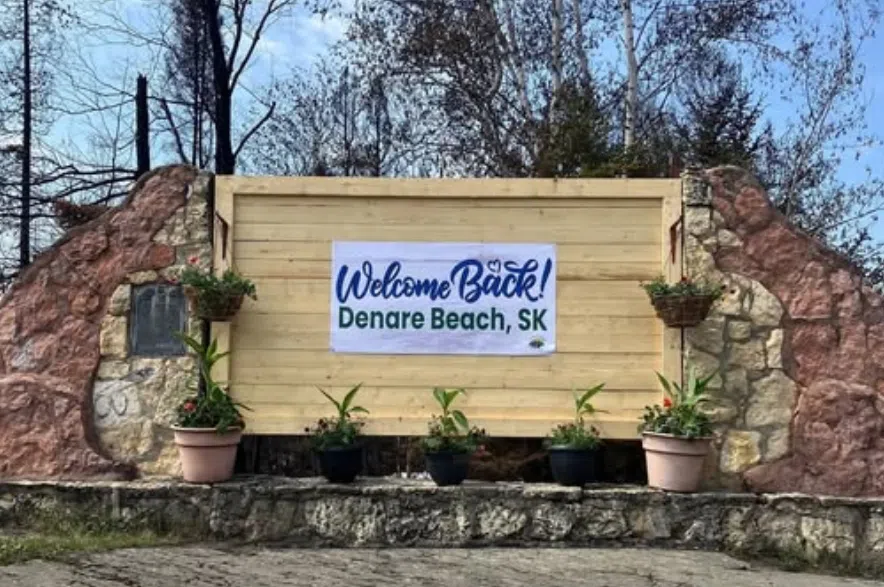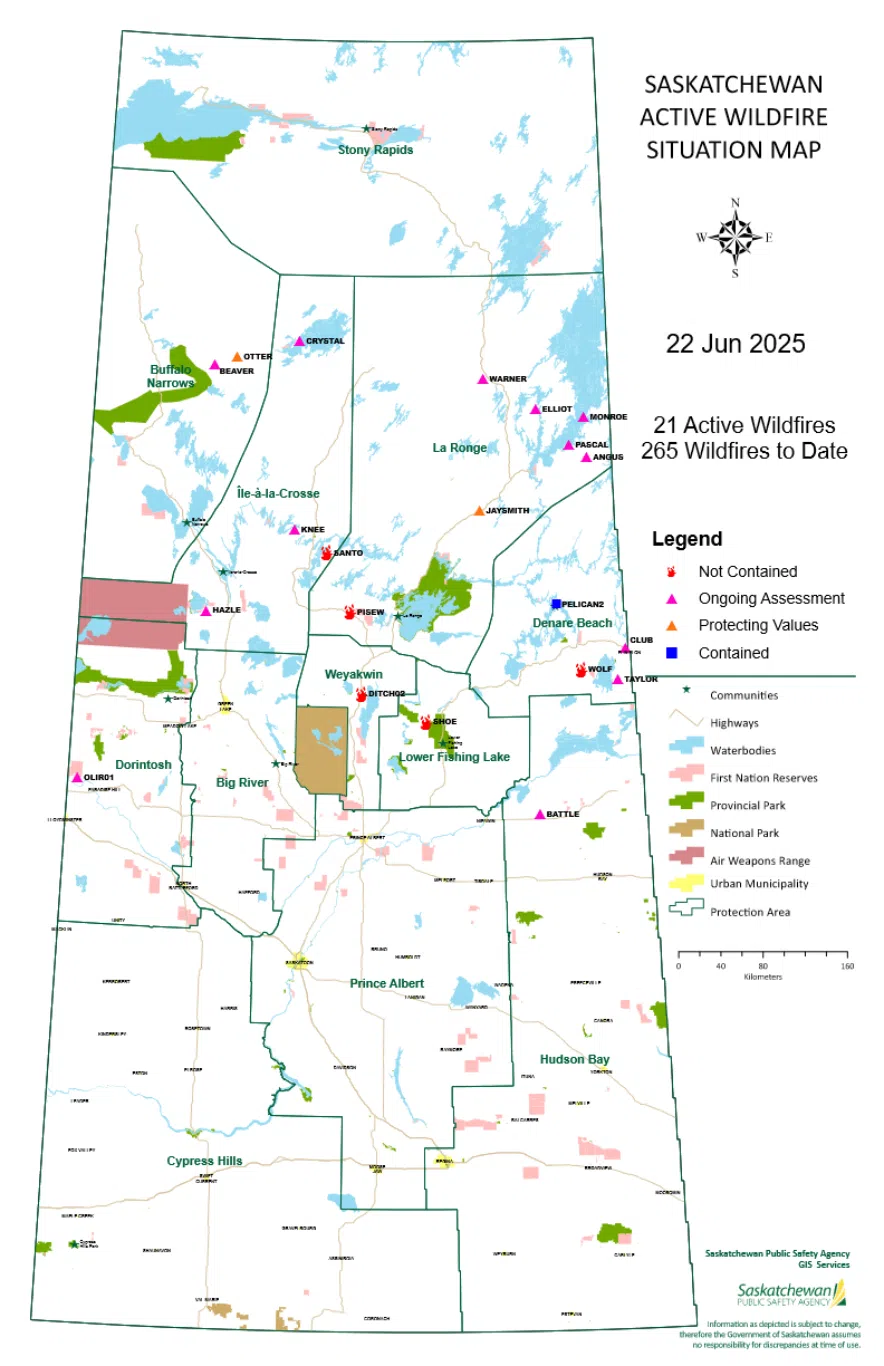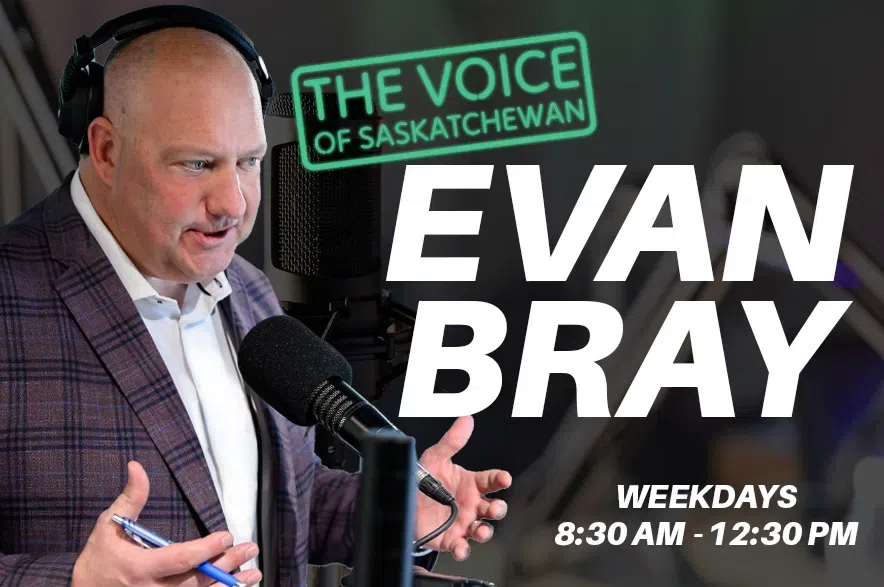There were 21 active fires burning in Saskatchewan on Sunday, while evacuees from Whelan Bay, Creighton and Denare Beach began returning to their communities.
Saskatchewan Public Safety Agency (SPSA) said on Friday that the provincial government’s Recovery Task Force will lead the efforts on getting impacted communities back up and running.
Read more:
- Task force to assist Whelan Bay, Creighton, and Denare Beach evacuees returning after wildfires
- New water bomber hasn’t flown since arriving in Saskatchewan
In its daily report on June 22, SPSA said that five of the 21 blazes were still not contained, while another 13 of the fires were under ongoing assessment and firefighters were protecting values in two. One fires was considered contained.
Contained means suppression action is taking place and the fire is not expected to grow in size, ongoing assessment means the fire is being monitored regularly to assess risk to values in the area and not contained means suppression action is taking place but the fire is expected to grow in size, according to SPSA. Protecting values means a fire is active and action is focused on protecting things like cabins and infrastructure.
The Shoe Fire, which SPSA said at 1 p.m. on Sunday was 554,484 ha (or nearly 1,370,160 acres nearly 10 times the size of the City of Saskatoon) is still not contained. Other fires with that status include the Pisew Fire, sized at 184,877 ha (or just over 456,841 acres which is around 10 times the size of the City of Regina) on Sunday, the Wolf Fire (161,420 ha or around 398,877 acres, which is about 24 times the size of the City of Prince Albert), and the 182,745 ha (nearly 451,573 acres) Ditch Fire.
As well, fire bans are active in 29 urban municipalities, 66 rural municipalities and 11 provincial parks in the province, with the fire danger considered low over much of Saskatchewan.
SPSA says there have been 267 fires in Saskatchewan so far in 2025. The five-year average to date for Saskatchewan wildfires is 160.
What do I need to know about fire bans?
SPSA provides the following information about fire bans in the province:
Is there a fire ban? If so, where?
• The interactive fire ban map found on saskpublicsafety.ca provides a view of the current, active fire bans and restrictions in Saskatchewan.
• If a local authority such as a municipality, a park or the SPSA have implemented a fire ban, details of each authority’s restrictions put in place can be found within the interactive map here.
• Check with a local authority for their bylaws and fire ban details. You should also check with the campground that you’re staying in for any fire restrictions they may have implemented.
Why was a fire ban implemented?
• The SPSA along with other Saskatchewan local authorities, such as a municipality, park or First Nations, have the authority to issue their own fire bans.
• A local authority may issue a fire ban when the risk of wildfires is deemed high and there is a need to reduce the likelihood of unwanted human-caused wildfires.
• The SPSA can issue a fire ban within Crown land, provincial parks, recreational areas, and the NSAD (Northern Saskatchewan Administration District).
• Each day, the SPSA assesses the implementation of a fire ban based on prevailing wildfire risks, ongoing wildfire occurrences, potential for new wildfires and long-range weather predictions.
When will a fire ban be lifted?
• It is up to the authority who issued the ban to rescind or modify the fire ban.
• A fire ban will be lifted or adjusted according to fluctuations in risk.
What fines or penalties are in place for violating a fire ban?
• As per The Wildfire Act, those in violation of a provincial fire ban order can face a fine of up to $500,000 per day (or part day) and/or imprisonment for up to three years. They could also be liable for covering the costs of the resulting wildfire.
• If someone violates a municipal fire bylaw, the fine would be pursuant to the municipal bylaw.
Why is there still a fire ban when it’s been rainy and/or cold for days?
• Although there may have been cooler temperatures and precipitation in some areas, the overall risk of wildfire can remain.
• If there are other fires burning across the province, local personnel may be deployed to those fires, which limits the resources available in lower-risk areas.
Is Crown land closed to the public during a fire ban?
• Crown land is not typically closed during a fire ban.
Who enforces the fire ban?
• Enforcement for fire bans is up to the jurisdiction. For example, in an RM or municipality, it would be the bylaw officer. In parks, it would be conservation officers or RCMP.
• SPSA would only be the enforcement lead on vacant Crown land.
Can I have a campfire?
• No, a fire ban means that campfires are not permitted as they represent a significant fire risk.
What types of outdoor cooking appliances are allowed during a fire ban?
• Propane and gas appliances, along with liquid fuelled stoves are permitted.
• Grills using charcoal briquettes are also permitted.
Are fireworks, firecrackers or sky lanterns allowed during a fire ban?
• No, fireworks, firecrackers and sky lanterns are not allowed during a fire ban as they pose a significant fire risk.
Are there restrictions on smoking in the areas covered under the ban?
• No, but visitors and residents are reminded to exercise extreme caution to help prevent wildfire. Properly dispose of smoking materials such as cigarettes.
Read more:












